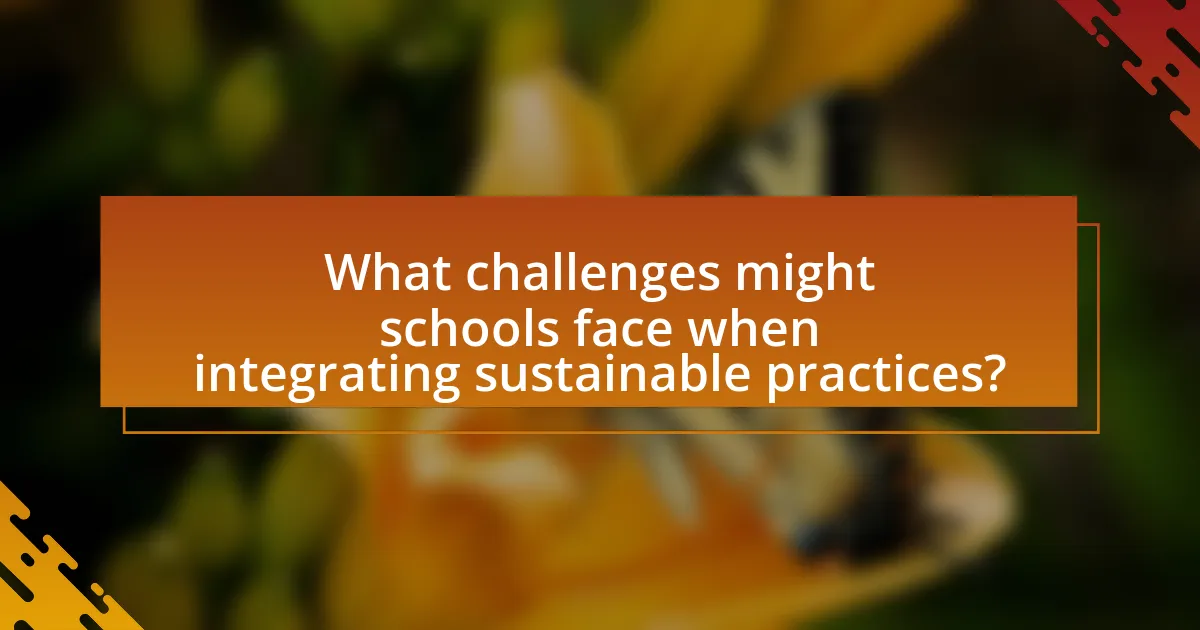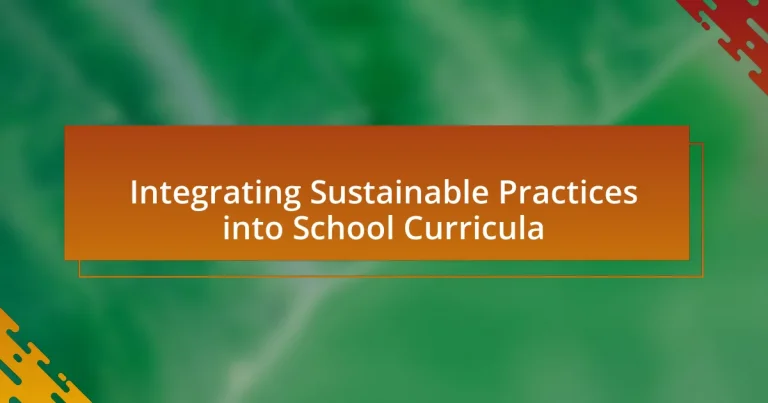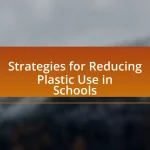Integrating sustainable practices into school curricula involves incorporating environmental education, resource conservation, and social responsibility into teaching methods and content. Key principles include environmental stewardship, social equity, and economic viability, which support educational goals by fostering critical thinking and responsible citizenship. The article outlines strategies for effective integration, such as project-based learning and interdisciplinary approaches, while also addressing challenges like funding limitations and resistance to change. Additionally, it emphasizes the long-term benefits for students and communities, including enhanced environmental awareness and improved academic performance.

What does integrating sustainable practices into school curricula entail?
Integrating sustainable practices into school curricula entails incorporating environmental education, resource conservation, and social responsibility into teaching methods and content. This integration involves developing lesson plans that emphasize sustainability concepts, such as climate change, biodiversity, and renewable energy, while also encouraging students to engage in hands-on projects like recycling programs and community gardens. Research indicates that schools implementing these practices can enhance students’ awareness and commitment to sustainability, as evidenced by a study from the National Environmental Education Foundation, which found that students exposed to environmental education demonstrate improved academic performance and increased civic engagement.
How can schools define sustainability in their curricula?
Schools can define sustainability in their curricula by incorporating principles that promote environmental stewardship, social equity, and economic viability. This definition can be operationalized through interdisciplinary approaches that integrate sustainability concepts across subjects, such as science, social studies, and economics. For instance, the United Nations Educational, Scientific and Cultural Organization (UNESCO) emphasizes the importance of education for sustainable development, which encourages schools to teach students about ecological conservation, social justice, and responsible citizenship. By aligning their curricula with frameworks like the Sustainable Development Goals (SDGs), schools can ensure that sustainability is a core component of their educational mission.
What are the key principles of sustainability that should be included?
The key principles of sustainability that should be included are environmental stewardship, social equity, and economic viability. Environmental stewardship emphasizes the responsible management of natural resources to protect ecosystems and biodiversity. Social equity focuses on ensuring fair access to resources and opportunities for all individuals, promoting inclusivity and community well-being. Economic viability involves creating systems that support long-term economic health while minimizing negative environmental impacts. These principles are essential for fostering a holistic approach to sustainability in educational curricula, as they encourage students to understand the interconnectedness of ecological, social, and economic systems.
How do these principles relate to educational goals?
The principles of integrating sustainable practices into school curricula directly support educational goals by fostering critical thinking, environmental awareness, and social responsibility among students. These principles encourage active learning and engagement with real-world issues, aligning with educational objectives that aim to develop informed and responsible citizens. For instance, research indicates that curricula incorporating sustainability lead to improved student outcomes in problem-solving and collaboration skills, which are essential for success in the 21st century.
Why is it important to integrate sustainable practices in education?
Integrating sustainable practices in education is crucial because it equips students with the knowledge and skills necessary to address environmental challenges. Education that incorporates sustainability fosters critical thinking and encourages responsible citizenship, enabling learners to make informed decisions about resource use and environmental stewardship. Research indicates that students exposed to sustainability concepts are more likely to engage in eco-friendly behaviors, as evidenced by a study published in the Journal of Environmental Education, which found that 75% of students reported increased awareness of environmental issues after participating in sustainability-focused curricula. This integration not only prepares students for future challenges but also promotes a culture of sustainability within communities.
What are the long-term benefits for students and communities?
Integrating sustainable practices into school curricula provides long-term benefits for students and communities by fostering environmental awareness and promoting responsible citizenship. Students develop critical thinking skills and a sense of agency, enabling them to address environmental challenges effectively. Research indicates that educational programs focused on sustainability lead to increased student engagement and improved academic performance, as seen in studies conducted by the National Environmental Education Foundation, which found that students involved in environmental education are more likely to excel in science and math. Communities benefit through enhanced collaboration and a shared commitment to sustainability, resulting in improved local ecosystems and a stronger sense of community identity.
How does sustainability education impact environmental awareness?
Sustainability education significantly enhances environmental awareness by equipping individuals with knowledge about ecological issues and sustainable practices. Research indicates that students exposed to sustainability curricula demonstrate increased understanding of environmental challenges, such as climate change and biodiversity loss. For instance, a study published in the Journal of Environmental Education found that students who participated in sustainability programs showed a 30% increase in their environmental knowledge and a greater likelihood of engaging in pro-environmental behaviors. This correlation suggests that sustainability education not only informs but also motivates individuals to take action towards environmental stewardship.

What strategies can be employed to integrate sustainable practices into school curricula?
To integrate sustainable practices into school curricula, educators can employ project-based learning, which engages students in real-world sustainability challenges. This approach allows students to explore environmental issues through hands-on projects, fostering critical thinking and problem-solving skills. Research from the National Environmental Education Foundation indicates that project-based learning enhances student engagement and retention of knowledge related to sustainability. Additionally, incorporating interdisciplinary lessons that connect sustainability with subjects like science, social studies, and economics can provide a comprehensive understanding of environmental impacts. Schools can also partner with local organizations to create experiential learning opportunities, such as community gardens or recycling programs, which reinforce sustainable practices in a practical context.
How can teachers incorporate sustainability into existing subjects?
Teachers can incorporate sustainability into existing subjects by integrating real-world environmental issues into lesson plans. For example, in science classes, teachers can explore topics like climate change, renewable energy, and ecosystems, using data from organizations such as the Intergovernmental Panel on Climate Change to provide factual context. In social studies, discussions can focus on the impact of human activities on the environment, referencing historical events like the Industrial Revolution and its ecological consequences. Mathematics lessons can include projects that analyze carbon footprints or resource consumption statistics, allowing students to apply mathematical concepts to sustainability metrics. This approach not only enhances students’ understanding of sustainability but also aligns with educational standards that emphasize critical thinking and problem-solving skills.
What are some effective teaching methods for sustainability education?
Effective teaching methods for sustainability education include project-based learning, experiential learning, and interdisciplinary approaches. Project-based learning engages students in real-world sustainability challenges, allowing them to apply knowledge and develop problem-solving skills. Experiential learning, such as field trips or community service projects, provides hands-on experiences that deepen understanding of sustainability concepts. Interdisciplinary approaches integrate sustainability across subjects, fostering a holistic view of environmental issues. Research shows that these methods enhance student engagement and retention of knowledge, making them effective for teaching sustainability.
How can project-based learning enhance sustainability understanding?
Project-based learning enhances sustainability understanding by engaging students in real-world problems that require them to explore and apply sustainable practices. This hands-on approach fosters critical thinking and collaboration, as students work together to develop solutions to environmental challenges, such as waste management or renewable energy projects. Research indicates that students involved in project-based learning demonstrate improved retention of knowledge and a deeper understanding of sustainability concepts, as they are actively participating in the learning process rather than passively receiving information. For instance, a study published in the Journal of Environmental Education Research found that students who participated in project-based learning focused on sustainability showed a 30% increase in their understanding of ecological principles compared to traditional learning methods.
What role do school policies play in promoting sustainability?
School policies play a crucial role in promoting sustainability by establishing guidelines and frameworks that encourage environmentally responsible behaviors among students and staff. These policies can include initiatives such as waste reduction programs, energy conservation measures, and the integration of sustainability into the curriculum. For example, schools that implement recycling programs and energy-efficient practices not only reduce their ecological footprint but also educate students about the importance of sustainability. Research indicates that schools with strong sustainability policies see increased student engagement in environmental issues, fostering a culture of sustainability that extends beyond the classroom.
How can schools develop policies that support sustainable practices?
Schools can develop policies that support sustainable practices by implementing comprehensive sustainability frameworks that include curriculum integration, resource management, and community engagement. These frameworks should outline specific goals, such as reducing waste by 50% within five years or achieving energy efficiency improvements of 30% through renewable energy sources. Research indicates that schools adopting sustainability policies not only enhance environmental awareness among students but also improve operational efficiencies; for example, a study by the National Wildlife Federation found that schools with sustainability programs reported a 20% reduction in energy costs. By establishing clear guidelines and measurable objectives, schools can effectively foster a culture of sustainability that benefits both the educational environment and the broader community.
What are examples of successful sustainability policies in schools?
Successful sustainability policies in schools include comprehensive recycling programs, energy-efficient building designs, and the incorporation of environmental education into the curriculum. For instance, the Green Schools initiative in the United States promotes energy conservation and waste reduction, resulting in schools reducing energy costs by up to 30%. Additionally, schools like the Eco-Schools program in Europe implement action plans that engage students in sustainability projects, leading to increased awareness and behavioral changes regarding environmental issues. These policies not only enhance the educational experience but also contribute to significant reductions in carbon footprints and resource consumption within school communities.

What challenges might schools face when integrating sustainable practices?
Schools may face several challenges when integrating sustainable practices, including limited funding, lack of training, and resistance to change. Limited funding restricts the ability to implement new programs or infrastructure necessary for sustainability, such as energy-efficient systems or green materials. Lack of training for educators can hinder the effective teaching of sustainable practices, as teachers may not feel equipped to incorporate these concepts into their curricula. Additionally, resistance to change from staff, students, or the community can impede the adoption of sustainable practices, as stakeholders may be hesitant to alter established routines or invest in new initiatives. These challenges highlight the complexities involved in transitioning to more sustainable educational environments.
How can schools overcome resistance to change in curricula?
Schools can overcome resistance to change in curricula by actively involving stakeholders in the decision-making process. Engaging teachers, parents, and students in discussions about the benefits of integrating sustainable practices fosters a sense of ownership and reduces apprehension. Research indicates that when stakeholders are included, the likelihood of successful implementation increases significantly; for instance, a study by Fullan (2007) highlights that collaborative engagement leads to higher acceptance rates of curricular changes. Additionally, providing professional development and resources equips educators with the necessary tools to adapt to new curricula, further easing the transition.
What strategies can be used to engage stakeholders in sustainability efforts?
To engage stakeholders in sustainability efforts, schools can implement collaborative initiatives that involve students, parents, teachers, and community members. These initiatives can include forming sustainability committees that allow stakeholders to contribute ideas and resources, thereby fostering a sense of ownership and commitment to sustainability goals. Research indicates that schools that actively involve stakeholders in decision-making processes see increased participation and support for sustainability initiatives, as evidenced by a study published in the Journal of Environmental Education, which found that schools with stakeholder engagement reported a 30% increase in sustainability project participation.
How can schools address resource limitations for sustainability initiatives?
Schools can address resource limitations for sustainability initiatives by forming partnerships with local businesses and community organizations to secure funding and resources. Collaborating with these entities can provide schools access to grants, donations, and expertise that enhance sustainability projects. For example, a study by the National Education Association found that schools that partnered with local businesses reported a 30% increase in funding for sustainability initiatives. Additionally, schools can implement cost-saving measures such as energy efficiency upgrades, which can reduce operational costs and free up funds for sustainability programs.
What are the best practices for evaluating the effectiveness of sustainability integration?
The best practices for evaluating the effectiveness of sustainability integration in school curricula include establishing clear objectives, utilizing quantitative and qualitative metrics, and engaging stakeholders in the assessment process. Clear objectives provide a framework for what sustainability integration aims to achieve, such as increased student awareness or behavioral changes regarding environmental issues. Quantitative metrics, such as surveys measuring knowledge retention or behavioral changes, alongside qualitative assessments like student reflections or project evaluations, offer a comprehensive view of effectiveness. Engaging stakeholders, including teachers, students, and community members, ensures diverse perspectives are considered, enhancing the evaluation’s relevance and accuracy. Research by the National Environmental Education Foundation highlights that effective evaluation frameworks lead to improved educational outcomes and greater community involvement in sustainability initiatives.
How can schools measure student engagement and understanding of sustainability?
Schools can measure student engagement and understanding of sustainability through a combination of assessments, surveys, and project-based evaluations. These methods allow educators to gauge both the knowledge students have acquired and their active participation in sustainability initiatives. For instance, pre- and post-assessments can quantify knowledge gains, while surveys can capture students’ attitudes and interest in sustainability topics. Additionally, project-based evaluations, such as group projects focused on real-world sustainability challenges, provide insights into students’ collaborative skills and practical application of their knowledge. Research indicates that hands-on projects significantly enhance student engagement, as evidenced by a study published in the Journal of Environmental Education Research, which found that students involved in experiential learning showed a 30% increase in engagement levels compared to traditional learning methods.
What tools and metrics can be used for assessment?
Tools and metrics for assessment in integrating sustainable practices into school curricula include surveys, rubrics, and performance assessments. Surveys can gauge student attitudes and knowledge regarding sustainability, while rubrics provide clear criteria for evaluating student projects related to sustainable practices. Performance assessments, such as project-based learning tasks, allow educators to measure students’ application of sustainability concepts in real-world scenarios. These tools and metrics are essential for effectively evaluating the impact of sustainability education on student learning outcomes.
What practical steps can educators take to implement sustainable practices in their classrooms?
Educators can implement sustainable practices in their classrooms by incorporating recycling programs, using digital resources to reduce paper waste, and integrating sustainability topics into the curriculum. For instance, establishing a recycling program encourages students to participate in waste reduction, which can lead to a 20% decrease in waste generated, as reported by the Environmental Protection Agency. Utilizing digital tools for assignments and communication minimizes paper usage, aligning with the goal of reducing environmental impact. Additionally, integrating sustainability topics, such as climate change and renewable energy, into lessons fosters awareness and responsibility among students, preparing them to engage with real-world environmental challenges.


